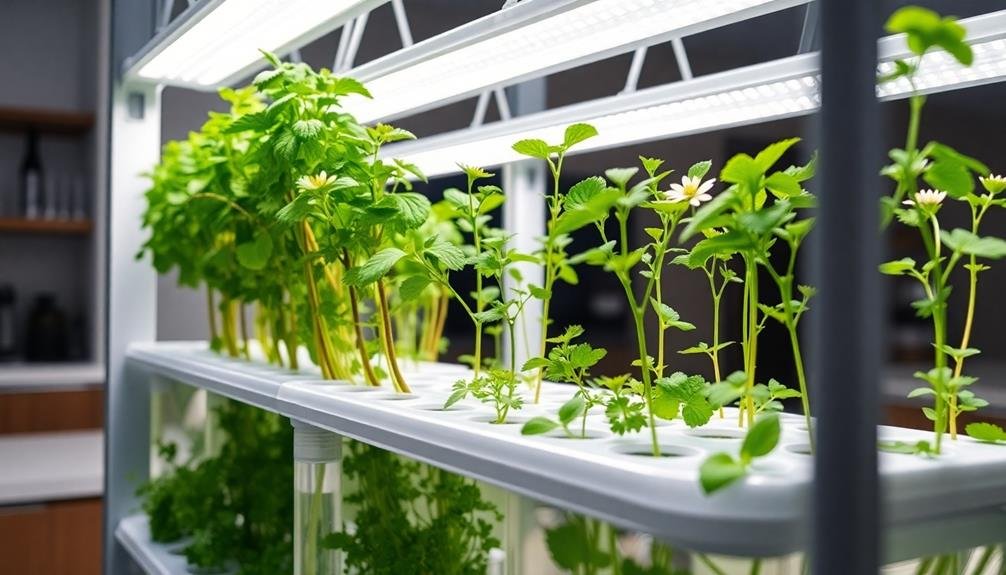You can easily cultivate your own herb tea by using one of these three effective indoor hydroponic systems. First, try the Nutrient Film Technique (NFT), which provides a continuous stream of nutrient-rich water and is perfect for herbs like mint and chamomile. Next, consider Deep Water Culture (DWC), where plant roots soak in a nutrient solution, facilitating rapid growth. Finally, the Ebb and Flow System floods your plants periodically, ensuring they get the right amount of hydration without overwatering. Each method has its perks, so keep exploring to find the right fit for your herb tea garden!
Nutrient Film Technique (NFT)

When it comes to growing herbs for tea, many enthusiasts find the Nutrient Film Technique (NFT) to be an efficient choice. This hydroponic method involves a thin film of nutrient-rich water flowing over the roots of your herbs. By using NFT, you create an ideal environment for your plants to thrive, as they receive ample oxygen and nutrients without being waterlogged.
You'll need a sloped trough or channel to set up your NFT system. This slope allows the nutrient film to flow continuously, guaranteeing your herbs get the hydration they need. You can choose a variety of herbs, like mint, chamomile, or lemon balm, which all adapt well to this method.
Just make certain your nutrient solution is balanced, focusing on the specific needs of each herb.
One of the main advantages of NFT is its efficiency. It uses less water than traditional soil methods, making it eco-friendly. Plus, you can grow your herbs indoors year-round, giving you fresh ingredients for your herbal teas regardless of the season.
Deep Water Culture (DWC)
Deep Water Culture (DWC) is a popular hydroponic method that immerses plant roots directly in a nutrient-rich solution. This technique allows plants to absorb nutrients and oxygen efficiently, promoting rapid growth and healthy yields. In DWC systems, you'll typically use a container filled with water and a nutrient solution, with a floating platform to support your plants. Air stones or diffusers can be added to keep oxygen levels high.
Here's a quick overview of the key components and benefits of DWC:
| Component | Description | Benefit |
|---|---|---|
| Nutrient Solution | A balanced mix of water and nutrients | Essential for plant growth |
| Air Pump | Provides oxygen to the roots | Prevents root rot, boosts growth |
| Net Pot | Holds the plant while roots grow | Allows roots to access water |
| Reservoir | Holds the nutrient solution | Maintains consistent moisture |
Ebb and Flow System

The Ebb and Flow System, often called a flood and drain system, efficiently delivers nutrient-rich water to your herbs while allowing the roots to breathe. This system works by periodically flooding your grow tray with water and then draining it back into a reservoir.
It's a simple yet effective way to guarantee your plants receive adequate hydration and nutrients.
Setting it up is straightforward. You'll need a grow tray, a reservoir, a submersible pump, and a timer. First, position your tray above the reservoir. Connect the pump to a timer, setting it to flood the tray at regular intervals.
When the timer activates, the pump will fill the tray with water. After a set time, the pump will shut off, allowing the water to drain back, leaving just enough moisture for the roots.
One of the main advantages of the Ebb and Flow System is its adaptability. You can easily customize the flooding schedule based on your herbs' needs.
This flexibility not only promotes healthy growth but also minimizes the risk of overwatering, guaranteeing your herb tea garden flourishes indoors.
Frequently Asked Questions
What Herbs Are Best for Indoor Hydroponic Tea Growing?
When considering herbs for indoor hydroponic tea growing, you'll find that mint, chamomile, and lemon balm thrive well. They're easy to manage, grow quickly, and provide aromatic flavors for delightful, invigorating teas you'll enjoy.
How Much Light Do Hydroponic Herbs Need Daily?
Hydroponic herbs need about 12 to 16 hours of light daily to thrive. You can use grow lights to provide consistent illumination, ensuring they receive the energy necessary for ideal growth and flavor development.
Can I Use Tap Water for Hydroponic Systems?
Yes, you can use tap water for hydroponic systems, but it's best to check for chlorine and other chemicals. Let it sit for 24 hours or use a water filter to improve quality.
How Do I Maintain Ph Levels in Hydroponics?
To maintain pH levels in hydroponics, regularly test the water using a pH meter. Adjust with pH up or down solutions as needed, and mix well to guarantee even distribution throughout your system.
What Is the Average Yield of Herbs in Hydroponics?
The average yield of herbs in hydroponics can vary, but you can expect around 1 to 2 pounds per square foot annually. Factors like light, nutrients, and plant type greatly influence your overall yield.
In Summary
To sum up, each of these indoor hydroponic systems—Nutrient Film Technique, Deep Water Culture, and Ebb and Flow—offers unique advantages for growing your own herb tea. Whether you prefer the simplicity of DWC or the efficient water management of NFT, you can enjoy fresh, homegrown herbs year-round. So, pick a system that suits your space and lifestyle, and start your journey toward delicious, aromatic herbal teas right from your own home!





Leave a Reply